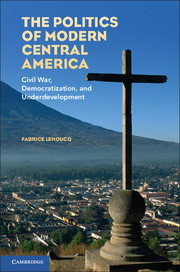Book contents
- Frontmatter
- Contents
- Figures
- Tables
- Introduction
- 1 Central America on the Eve of the 1980s
- 2 Civil War, Revolution, and Economic Collapse
- 3 Stalemates, Peace Negotiations, and Democratization
- 4 Economic Stability, Lackluster Growth, and Social Change
- 5 Democratization, State Capacity, and Redistribution
- Conclusion
- Bibliography
- Index
Conclusion
Published online by Cambridge University Press: 05 September 2012
- Frontmatter
- Contents
- Figures
- Tables
- Introduction
- 1 Central America on the Eve of the 1980s
- 2 Civil War, Revolution, and Economic Collapse
- 3 Stalemates, Peace Negotiations, and Democratization
- 4 Economic Stability, Lackluster Growth, and Social Change
- 5 Democratization, State Capacity, and Redistribution
- Conclusion
- Bibliography
- Index
Summary
On the eve of U.S. participation in World War I (1917–8), Dana Munro, an economics graduate student from the University of Pennsylvania traveled, not infrequently by horseback, in Central America. Munro would write The Five Republics of Central America (Munro, 1918) and, even later, refashion many of the letters he sent his parents as a traveler’s account (Munro, 1983). Both are remarkable, not only for their vivid descriptions of political life in countries dominated by dictatorship, but also for the thesis that political instability contributed to underdevelopment – an argument unfortunately forgotten in subsequent decades, when scholarship assumed that the region’s model of economic development made autocracy inevitable.
More than sixty years later, I found myself traveling in the region, although mostly by airplane, bus, and car. Like the young Munro, I too went to Central America in search of answers to basic questions about the nature of political instability. Like my predecessor, I landed in a region very much the target of U.S. foreign policy makers. Although Munro analyzed the consequences of the U.S. decision to prop up a conservative regime in Nicaragua between 1913 and 1933 (that would involve deploying marines), I observed the impact of U.S. foreign policy, based on fighting communists, six decades later. As in Munro’s youth, U.S. policy toward the region in the 1980s was controversial and the staple of the daily news.
- Type
- Chapter
- Information
- The Politics of Modern Central AmericaCivil War, Democratization, and Underdevelopment, pp. 152 - 166Publisher: Cambridge University PressPrint publication year: 2012

